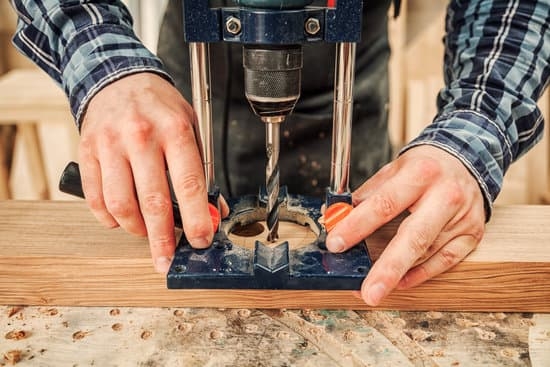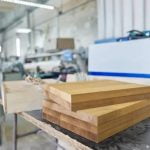What is a stressed joint woodworking? In the world of woodworking, a stressed joint refers to a method of joining two pieces of wood together using interlocking connections that rely on the stress within the joint itself to hold it together. This technique has been used for centuries and continues to be popular among craftsmen for its strength and durability.
The history of stressed joint woodworking dates back to ancient times when artisans discovered the benefits of creating strong joints by strategically shaping and fitting pieces of wood together. Over the years, this method has evolved and been refined into various types of joints, each with its unique characteristics and advantages.
There are several types of stressed joints commonly used in woodworking, such as dovetail joints, mortise and tenon joints, and halved joints. These joints offer different levels of strength and aesthetic appeal, making them suitable for various projects ranging from furniture making to structural construction. By understanding the intricacies of each type, woodworkers can choose the most appropriate joint for their specific needs.
History of Stressed Joint Woodworking
Stressed joint woodworking has a long history that dates back centuries, with its origins rooted in the need for sturdy and durable construction methods. This technique involves creating joints that are designed to withstand significant stress and weight, making them ideal for structural components of furniture, buildings, or other woodworking projects. The evolution of stressed joint woodworking can be traced through the different styles and techniques developed over time to improve strength and durability.
Throughout history, woodworkers have experimented with various types of stressed joints to achieve different levels of strength and stability in their creations. One of the earliest known types of stressed joint is the mortise and tenon joint, which dates back to ancient times and continues to be widely used today.
This type of joint involves inserting a protruding tenon from one piece of wood into a corresponding hole or slot (mortise) in another piece, creating a strong connection that can withstand heavy loads.
Another popular type of stressed joint in woodworking is the dovetail joint, known for its interlocking design that provides exceptional resistance to pulling forces. The unique shape of dovetails makes them particularly effective in drawer construction, where the joints need to endure constant movement and weight.
Additionally, halved joints are simple yet effective stressed joints that offer good strength for basic woodworking projects. These joints involve cutting two pieces of wood at an angle and fitting them together like puzzle pieces to create a secure bond.
- Mortise and Tenon Joint
- Dovetail Joint
- Halved Joints
Overall, the history of stressed joint woodworking showcases the ingenuity and craftsmanship of woodworkers throughout the ages as they adapted traditional techniques to meet changing needs and trends in construction. By understanding the origins and evolution of this technique, modern woodworkers can continue to build upon this legacy by incorporating stressed joints into their own projects for enhanced strength and durability.
Types of Stressed Joints
Stressed joint woodworking involves the use of various techniques to create strong and durable connections between pieces of wood. One of the key aspects of this method is the variety of joint types that are utilized to ensure structural integrity in woodworking projects. Understanding the different types of stressed joints is crucial for woodworkers looking to enhance the strength and longevity of their creations.
Here is an overview of some common types of stressed joints used in woodworking:
- Dovetail Joints: Dovetail joints are known for their resistance to being pulled apart, making them ideal for creating drawers, cabinets, and boxes. This type of joint consists of a series of pins and tails that interlock with one another, providing a tight connection that can withstand stress.
- Mortise and Tenon Joints: Mortise and tenon joints involve a protruding tenon on one piece that fits into a cavity or mortise on another piece, creating a strong bond. These joints are commonly used in furniture construction due to their stability and ability to support heavy loads.
- Halved Joints: Halved joints are simple yet effective connections where two pieces of wood are joined by cutting away half the thickness from each piece and fitting them together. While not as intricate as dovetail or mortise and tenon joints, halved joints can still provide adequate strength for certain woodworking projects.
These different types of stressed joints offer flexibility in design while ensuring the overall stability and durability of wooden structures. By choosing the appropriate joint type based on the specific requirements of a project, woodworkers can elevate their craftsmanship and create long-lasting pieces that stand the test of time.
Benefits of Stressed Joint Woodworking
Stressed joint woodworking, also known as joinery, is a technique that involves creating strong and durable connections between two or more pieces of wood. This method has been used for centuries by craftsmen to construct furniture, cabinets, and other wooden structures. The concept behind stressed joint woodworking is to distribute the weight and stress placed on the joint evenly throughout the connected pieces, making it more stable and less likely to fail over time.
One of the main benefits of stressed joint woodworking is the strength and durability it provides to the finished piece. By using strong joints like dovetail, mortise and tenon, or halved joints, craftsmen can ensure that their creations will withstand everyday use and last for generations. These joints are designed to lock the pieces of wood together securely, creating a seamless connection that can support heavy loads without weakening or loosening over time.
In addition to strength and durability, stressed joint woodworking also offers an aesthetic appeal to the finished product. The clean lines and precise fit of well-crafted joints enhance the overall look of furniture and structures, giving them a sense of craftsmanship and quality. Whether you are building a simple wooden box or an intricate piece of furniture, incorporating stressed joints into your woodworking projects can elevate the design and add value to your work.
Tools and Materials Needed for Stressed Joint Woodworking
Essential Tools for Stressed Joint Woodworking
When embarking on a woodworking project that involves stressed joint techniques, it is crucial to have the right tools at your disposal. Some essential tools include a saw for cutting the wood precisely, chisels for carving out the joints, a mallet for driving the chisel, and a marking gauge for measuring and marking areas for cuts. Additionally, clamps are necessary to hold the pieces together during assembly, ensuring a tight and secure joint.
Materials Required for Stressed Joint Woodworking
In addition to having the correct tools, it is equally important to use the appropriate materials when practicing stressed joint woodworking. High-quality hardwoods such as oak, maple, walnut, or cherry are commonly used due to their strength and durability. These types of wood can withstand the stress put on joints over time, making them ideal choices for furniture or structures that require longevity.
Additional Supplies for Stressed Joint Woodworking
Along with tools and quality wood materials, other supplies play a significant role in successful stressed joint woodworking projects. Glue is essential for ensuring a strong bond between joint pieces, while sandpaper helps smooth out rough edges after assembly. Wax or finish can also be applied to protect the wood and enhance its appearance. By having all these tools and materials on hand, craftsmen can confidently create sturdy and visually appealing joints in their woodworking projects.
Step-by-Step Guide to Creating a Stressed Joint
Stressed joint woodworking is a technique used in woodworking to create strong and durable joints between two pieces of wood. By carefully cutting and fitting the wood together, the resulting joint can withstand significant stress and pressure, making it ideal for furniture and other structural applications. This method has been used for centuries and is still popular among modern woodworkers due to its reliability and strength.
One of the most common types of stressed joints is the dovetail joint, known for its interlocking design that prevents pulling apart. Another popular type is the mortise and tenon joint, which involves inserting a projecting part (the tenon) into a hole (the mortise) to create a secure connection. Additionally, halved joints are often used in stressed joint woodworking, where one piece of wood overlaps another at a right angle to form a strong bond.
To create a stressed joint in woodworking, you will need essential tools such as a saw, chisels, mallet, marking gauge, and clamps. Additionally, you will require quality wood that is well-suited for the specific joint you’re creating. By following a step-by-step guide and taking your time to ensure precise measurements and cuts, you can successfully achieve a stressed joint that will enhance the strength and longevity of your woodworking projects.
| Types of Stressed Joints | Description |
|---|---|
| Dovetail Joint | Interlocking design preventing pulling apart |
| Mortise and Tenon Joint | Tenon inserted into mortise for secure connection |
| Halved Joint | One piece overlaps another at right angle for strong bond |
Common Mistakes to Avoid in Stressed Joint Woodworking
Stressed joint woodworking is a technique that involves creating joints under tension or compression, adding strength and durability to the overall structure of a piece. It is crucial to execute this method correctly to ensure the longevity and stability of your woodworking projects. In this section, we will discuss common mistakes to avoid in stressed joint woodworking, providing you with tips on preventing errors and ensuring a successful outcome.
One common mistake in stressed joint woodworking is rushing through the process without proper planning and preparation. Before starting any project that involves stressed joints, it is essential to take the time to carefully measure and plan out each step. Rushing can lead to inaccuracies in your cuts or misalignments in your joints, compromising the integrity of the final product.
Another mistake to avoid is neglecting to choose the right type of stressed joint for your specific project. Different types of stressed joints, such as dovetail, mortise and tenon, or halved joints, serve different purposes and have varying levels of strength. It is important to select the most appropriate joint for your project based on factors like weight-bearing requirements or aesthetic preferences. Using the wrong type of joint can result in structural weaknesses and potential failure over time.
Lastly, overlooking proper clamping techniques can be a significant error in stressed joint woodworking. Applying uneven pressure or not providing enough clamping force during glue-ups can result in gaps or misalignments in your joints. To prevent this issue, make sure to use adequate clamps evenly distributed along the joint lines and check for alignment throughout the drying process.
| Stressed Joint Woodworking Mistakes | Tips for Success |
|---|---|
| Rushing through the process without planning | Take time to measure and plan each step carefully. |
| Choosing the wrong type of stressed joint | Select the most suitable joint for your project based on requirements. |
| Neglecting proper clamping techniques | Use adequate clamps evenly distributed along joint lines during glue-ups. |
Examples of Projects Using Stressed Joint Woodworking
One of the best ways to truly understand the beauty and strength of stressed joint woodworking is by looking at real-life examples of furniture or structures built using this technique. This method has been utilized for centuries to create sturdy and durable pieces that stand the test of time. From intricate furniture pieces to architectural wonders, stressed joint woodworking showcases the craftsmanship and skill of woodworkers.
Traditional Furniture Pieces
In traditional furniture making, stressed joint woodworking is often used to create strong and long-lasting pieces. For example, a classic dovetail joint can be seen in high-end wooden cabinets where the tails and pins interlock securely, providing stability and durability. By using this technique, craftsmen are able to create furniture that not only looks exquisite but also functions flawlessly for years to come.
Architectural Structures
Beyond furniture, stressed joint woodworking has also been applied in creating architectural structures such as bridges and buildings. The use of mortise and tenon joints in timber framing allows for large wooden beams to be joined together securely without the need for modern fasteners. This traditional method can be seen in historical structures around the world, showcasing the timeless appeal and strength of stressed joint woodworking in construction.
Artistic Woodworking
Stressed joint woodworking is not limited to practical applications but also extends into artistic expressions. Intricate scrollwork, decorative inlays, and unique joinery techniques are often used by wood artists to create one-of-a-kind masterpieces. By incorporating stressed joints into their creations, these artists are able to push the boundaries of what is possible with wood, resulting in stunning pieces that captivate viewers with both form and function.
Conclusion
Stressed joint woodworking is a technique that has withstood the test of time, proving to be a fundamental aspect of woodworking craft. Through the centuries, this method has been refined and perfected, contributing to the creation of durable and robust joints that stand the test of time. The history of stressed joint woodworking showcases the ingenuity and skill of craftsmen who have employed this technique to create sturdy structures and furniture pieces.
The types of stressed joints, such as dovetail, mortise and tenon, and halved joints, offer a versatile range of options for woodworkers to choose from based on their specific project needs. These joints provide strength and stability to the overall structure, ensuring longevity and durability. By understanding the benefits of stressed joint woodworking, craftsmen can elevate their creations to new heights by incorporating these techniques into their projects.
In conclusion, stressed joint woodworking plays a crucial role in the craft industry by providing woodworkers with a reliable method for creating strong and enduring joints. By following a step-by-step guide and avoiding common mistakes in the process, craftsmen can achieve exceptional results in their woodworking projects. With the right tools, materials, and knowledge in hand, woodworkers can harness the power of stressed joint woodworking to bring their visions to life with precision and craftsmanship.
Frequently Asked Questions
What Is Stressed Joint Wood?
Stressed joint wood is a type of woodworking joint where the pieces are joined together using pressure and stress rather than traditional methods like glue or nails. This technique involves bending the pieces to fit together tightly, creating a strong bond without the need for additional materials.
What Is the Weakest Woodworking Joint?
The weakest woodworking joint is often considered to be the butt joint. This type of joint involves simply joining two pieces of wood together at their ends without any additional reinforcements like glue or screws. As a result, butt joints can be prone to breaking or coming apart under stress compared to other types of joints.
What Are the Hardest Joints in Woodworking?
Some of the hardest joints in woodworking include dovetail joints, mortise and tenon joints, and complex joinery like Japanese joinery techniques. These joints are known for their strength, durability, and ability to withstand heavy loads and stress over time. While they may be more challenging to create, the end result is a long-lasting and sturdy piece of craftsmanship.

Hi everyone! I’m a woodworker and blogger, and this is my woodworking blog. In my blog, I share tips and tricks for woodworkers of all skill levels, as well as project ideas that you can try yourself.





